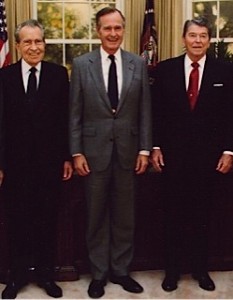
Presidents Richard Nixon, George H.W. Bush and Ronald Reagan photographed together in the Oval Office in 1991. (Cropped from a White House photo that also included Presidents Gerald Ford and Jimmy Carter.)
Indeed, newly disclosed documents have put old evidence into a sharply different light and suggest that history has substantially miswritten the two scandals by failing to understand that they actually were sequels to earlier scandals that were far worse. Watergate and Iran-Contra were, in part at least, extensions of the original crimes, which involved dirty dealings to secure the immense power of the presidency.
Shortly after Nixon took office in 1969, FBI Director J. Edgar Hoover informed him of the existence of the file containing national security wiretaps documenting how Nixon's emissaries had gone behind President Lyndon Johnson's back to convince the South Vietnamese government to boycott the Paris Peace Talks, which were close to ending the Vietnam War in fall 1968.
The disruption of Johnson's peace talks then enabled Nixon to hang on for a narrow victory over Democrat Hubert Humphrey. However, as the new President was taking steps in 1969 to extend the war another four-plus years, he sensed the threat from the wiretap file and ordered two of his top aides, chief of staff H.R. "Bob" Haldeman and National Security Advisor Henry Kissinger, to locate it. But they couldn't find the file.
We now know that was because President Johnson, who privately had called Nixon's Vietnam actions "treason," had ordered the file removed from the White House by his national security aide Walt Rostow.
Rostow labeled the file "The "X' Envelope" and kept it in his possession, although having left government, he had no legal right to hang on to the highly classified documents, many of which were stamped "Top Secret." Johnson had instructed Rostow to retain the papers as long as he, Johnson, was alive and then afterwards to decide what to do with them.
Nixon, however, had no idea that Johnson and Rostow had taken the missing file or, indeed, who might possess it. Normally, national security documents are passed from the outgoing President to the incoming President to maintain continuity in government.
But Haldeman and Kissinger had come up empty in their search. They were only able to recreate the file's contents, which included incriminating conversations between Nixon's emissaries and South Vietnamese officials regarding Nixon's promise to get them a better deal if they helped him torpedo Johnson's peace talks.
So, the missing file remained a troubling mystery inside Nixon's White House, but Nixon still lived up to his pre-election agreement with South Vietnamese President Nguyen van Thieu to extend U.S. military participation in the war with the goal of getting the South Vietnamese a better outcome than they would have received from Johnson in 1968.
Nixon not only continued the Vietnam War, which had already claimed more than 30,000 American lives and an estimated one million Vietnamese, but he expanded it, with intensified bombing campaigns and a U.S. incursion into Cambodia. At home, the war was bitterly dividing the nation with a massive anti-war movement and an angry backlash from war supporters.
Pentagon Papers
It was in that intense climate in 1971 that Daniel Ellsberg, a former senior Defense Department official, gave the New York Times a copy of the Pentagon Papers, the secret U.S. history of the Vietnam War from 1945 to 1967. The voluminous report documented many of the lies -- most told by Democrats -- to draw the American people into the war.
The Times began publishing the Pentagon Papers on June 13, 1971, and the disclosures touched off a public firestorm. Trying to tamp down the blaze, Nixon took extraordinary legal steps to stop dissemination of the secrets, ultimately failing in the U.S. Supreme Court.
But Nixon had an even more acute fear. He knew something that few others did, that there was a sequel to the Pentagon Papers that was arguably more explosive -- the missing file containing evidence that Nixon had covertly prevented the war from being brought to a conclusion so he could maintain a political edge in Election 1968.
If anyone thought the Pentagon Papers represented a shocking scandal -- and clearly millions of Americans did -- how would people react to a file that revealed Nixon had kept the slaughter going -- with thousands of additional American soldiers dead and the violence spilling back into the United States -- just so he could win an election?
A savvy political analyst, Nixon recognized this threat to his reelection in 1972, assuming he would have gotten that far. Given the intensity of the anti-war movement, there would surely have been furious demonstrations around the White House and likely an impeachment effort on Capitol Hill.
So, on June 17, 1971, Nixon summoned Haldeman and Kissinger into the Oval Office and -- as Nixon's own recording devices whirred softly -- pleaded with them again to locate the missing file. "Do we have it?" Nixon asked Haldeman. "I've asked for it. You said you didn't have it."
Next Page 1 | 2 | 3 | 4 | 5 | 6
(Note: You can view every article as one long page if you sign up as an Advocate Member, or higher).





